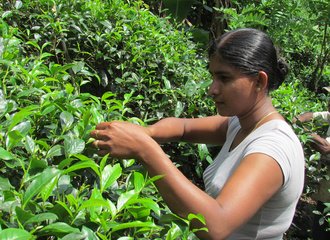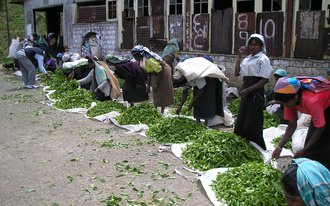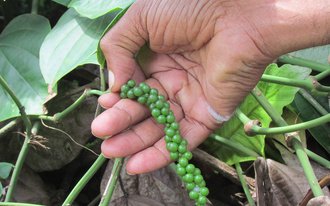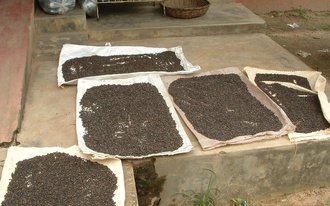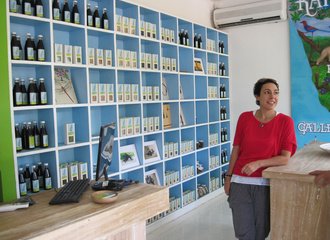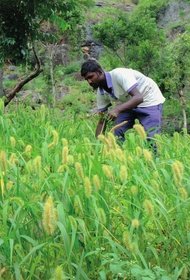Rich Forests
Rich Forests promotes a sustainable and future-proof production system and supports, among other things, the transformation of degraded land into food forests. With this, people provide for their livelihood, increase their income and at the same time restore soil and biodiversity.
Forests are crucial to the livelihoods of 1.2 billion people in developing countries, to pick fruits, nuts and berries, harvest honey and resin, gather herbs used as medicine, find construction materials for their houses and collect firewood. Unfortunately, Large tracks of forest land have disappeared in the last 20 to 30 years, causing millions of people to lose their essential resources and means of living. Intensive (livestock) farming and the relentless need for new agricultural land are the main drivers for deforestation, causing fertile soil to erode, clean rivers to be polluted with pesticides and making the consequences of climate change tangible for everyone.
Restoring degraded areas and protecting what is still there
But what if degraded land could be restored to its original state, or even better, to 'rich forests', not only providing a good habitat for plants and animals, but also enabling local people to create sustainable livelihoods through the use and sale of forest products? Since the 1980s, our partners around the world have shown that this is feasible. They created food forests, in which crops that do well in the climate and circumstances of that particular area, such as bananas, papayas, coffee beans, tea leaves, herbs, spices and rattan are cultivated in between te trees, yielding products that can be sold. In addition, our partners have been working for decades to protect existing forests so that they can be used by local communities to sustainably harvest non-timber forest products such as nuts, berries and honey.
Both ENDS and Rich Forests
The 'Rich Forests' initiative is an alliance of Both ENDS and two international networks of organisations that have been successful in transforming degraded lands into productive food forests (Analog Forestry) as well as in sustainably cultivating and harvesting non timber forest products (NTFPs). Rich Forests' objective is to help local producers improve the production and marketing of forest products and to link them to social entrepreneurs and investors. At the same time, Rich Forests provides services to agro-industrial companies so that forest degradation as a consequence of their production chains is restored sustainably and with clear benefits for society.
Pilot sites and research
To ensure that food forests are productive and financially viable – also in the very long term –Rich Forests focuses on a number of important aspects. We establish pilot sites in various climatological circumstances, to see which crops grow best in which locations, in the best combinations and with the best yield. The findings are recorded and supplemented with data on possible improvements in soil conditions, water levels and biodiversity that we gather together with scientific institutes.
Marketing
Because food and other products from forests are explicitly intended, besides for own use, to be sold to increase incomes, Rich Forests and our partners work together to explore ways to market them locally, nationally and even internationally.
Advocacy
A final important aspect of our work is influencing local and national policy, especially in the areas of property and land-use rights. In many countries, these rights are not enshrined in law, so that small farmers and communities can be driven from their land at any time. That uncertainty discourages them from investing in long-term projects, like food forests. By showing that Analog Forestry works on a small scale, we are persuading policy-makers of the potential of existing and restored forests as sources of food and income, for regulating air and water quality, and as buffers against climate change, so that they will make this form of agriculture a regular component of future policy.
For more information
Read more about this subject
-
Transformative Practice
Non-Timber Forest Products (NTFPs)
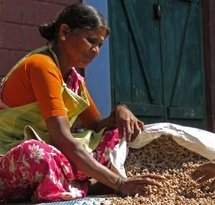
About one in every six people, particularly women, directly rely on forests for their lives and livelihoods, especially for food. This shows how important non-timber forest products (NTFPs) and forests are to ensure community resilience. Not only as a source of food, water and income, but also because of their cultural and spiritual meaning.
-
Transformative Practice
Inclusive Land Governance
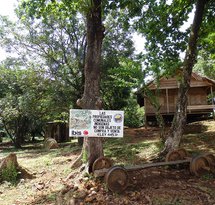
Both ENDS works with partners around the world to ensure that land is governed fairly and inclusively and managed sustainably with priority for the rights and interests of local communities.
-
Dossier
Inclusive ways to sustainable and healthy food for all
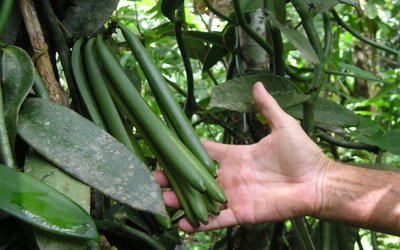
All around the world small-scale farmers are using sustainable and inclusive methods to produce food. Working together with nature and each other, they provide their families and communities with sufficient and healthy food. But their production methods are under pressure from large-scale agriculture and the globally dominant system of industrial food production. Together with our partners, Both ENDS is trying to turn the tide in favour of sustainable, local practices that are mostly known as 'agro-ecological' or 'nature-inclusive'. Why are we focusing on these methods? Agro-ecological practices are climate-proof and inclusive and increase the opportunities for communities around the world to produce their food sustainably.
-
Dossier
The merits of community-based restoration
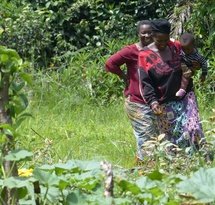
Globally, the area that is suffering desertification and land degradation is ever expanding. Unsustainable and often large-scale agricultural practices, including the copious use of pesticides and fertilisers, are a major driver of land degradation, aprocess that is further exacerbated by climate change, causing more erratic rainfall patterns, longer periods of drought and unpredictable growing seasons. This is very problematic not only for the hundreds of millions of people who directly depend on land and water for their livelihoods, but also for life on earth as a whole. It is clear that this process must be stopped and reversed, better sooner than later. But how to go about it?
-
Dossier
Wetlands without Borders

With our Wetlands without Borders program, we work towards environmentally sustainable and socially responsible governance of the wetlands system of the La Plata Basin in South America.
-
Dossier
Communities Regreen the Sahel
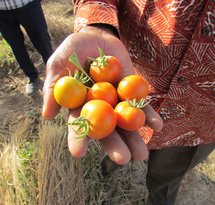
In various countries in the Sahel, vast tracts of land have been restored by the local population by nurturing what spontaneously springs from the soil and protecting the sprouts from cattle and hazards.
-
Dossier
Participatory Land Use Planning (PLUP)
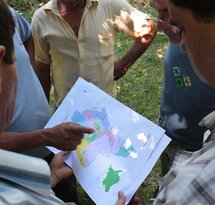
Participatory Land Use Planning (PLUP) is a rights-based approach ensuring inclusive and gender-responsive land governance, especially for those whose rights to land are not fully acknowledged.
-
News / 13 October 2023
Water is life, water is food: World Food Day 2023
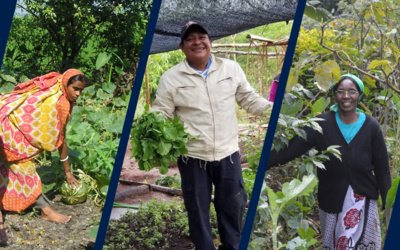
"Water is life, water is food" is this year's theme for World Food Day. Our partners around the world know all too well that this is a very true sentence. To celebrate World Food Day 2023 this October 16th, we'd like to show a few examples of how our partners fight for the right to water and this way, contribute to local food sovereignty at the same time.
-
Press release / 21 April 2023
Manifesto: The Netherlands can reduce its international footprint with new Agricultural Agreement
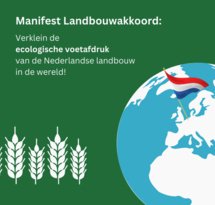
The Dutch Agriculture Agreement, which is currently under development, is too much focused solely on the Netherlands. That is the opinion of a broad coalition of more than sixty NGOs, farmers' organisations, scientists and companies that have today sent an urgent letter to agriculture minister Piet Adema and foreign trade and development minister Liesje Schreinemacher. The government's agricultural policy should also aim to reduce the Netherlands' enormous agrarian footprint beyond our borders, by taking food security and the preservation of biodiversity as its starting points. The coalition has published a manifesto in which it sets out how reform of the Netherlands' foreign agricultural policy could be given shape.
-
Press release / 7 March 2022
New report: investment in agroecology necessary for healthy global food system
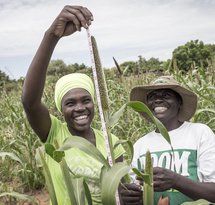
A recent study by Profundo for Both ENDS and Oxfam Novib shows that investment in agroecology is necessary for a sustainable and inclusive global food system. Today, some 768 million – one in ten – people suffer from hunger or a severe shortage of food on a daily basis. Conflict, economic stagnation caused by the Corona epidemic, and the climate crisis present an immediate threat to the production of and access to sufficient nutritious food. Agroecology, a form of agriculture that places small-scale farmers, the natural environment and short supply chains at the centre of food production, makes communities in developing countries more resilient and helps them combat hunger. The study concludes however that major donors, including the Netherlands, are so far providing insufficient support for agroecology.
-
Event / 7 December 2021, 14:00 - 15:15
WEBINAR: EU's push for strong Intellectual Property Rights (IPR) on seeds
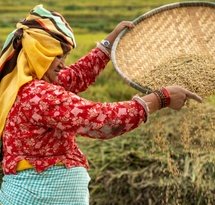
The European Union's (EU) foreign trade policy has many implications for the sustainability of food systems in developing countries, heavily impacting farmers, breeders, and citizens. The unhidden promotion by the EU of strong intellectual property rights on plants affects food systems from its very basis, i.e., the seeds that are available for farmers to grow. Amongst these intellectual property rights, the main instrument that is advocated by European authorities is the 1991 Act of the UPOV Convention, which provides exclusive rights to breeders over the propagating material of new plant varieties, while diminishing the rights of others to use the material for further breeding and hampering with the rights of farmers to freely save, use, exchange and sell their seeds.
-
Publication / 29 November 2021
-
News / 30 September 2021
Agroecology in Kenya: fighting water pollution while securing food production
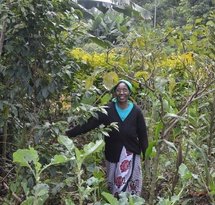
About 75% of Kenyans earn all or part of their income from the agriculture sector which accounts for 33% of the country's Gross Domestic Product (GDP). However, agricultural productivity has stagnated in recent years. Various factors have contributed to low agricultural productivity, including an overall decline in soil fertility because of the continuous removal of nutrients by crops; poor farming practices; land degradation and overuse/misuse of synthetic fertilizers that acidify the soil. The solution against these problems is: agroecology.
-
News / 27 September 2021
Analog Forestry: sustainable food production with a feminist perspective
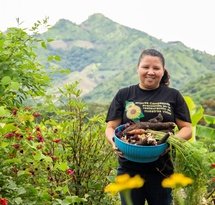
In times of ecosystem degradation, deforestation and climate change, rural communities often struggle to make a living in a healthy and autonomous way. One of the solutions to counter their problems is Analog Forestry, a sustainable practice promoted by many of Both ENDS's partners. We spoke to Carolina Sorzano Lopez*, Analog Forestry trainer from Colombia for the International Analog Forestry Network (IAFN), and Luz Marina Valle*, a local Analog Forestry promotora in her community of El Jocote in Northern Nicaragua, to explain to us the advantages of Analog Forestry.
-
News / 17 September 2021
Beyond trees: the importance of Non-Timber Forest Products for communities
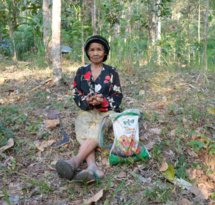
About one in every six people, particularly women, directly rely on forests for their lives and livelihoods, especially for food. This shows how important non-timber forest products (NTFPs) and forests are to ensure community resilience. Not only as a source of food, water and income, but also because of their cultural and spiritual meaning.
-
News / 19 August 2021
Violet Matiru: “Communities around colonial Ruiru I Dam still struggle”
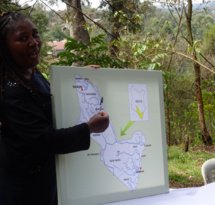
After many years of advocating for strong environmental policies at international platforms such as the UN, Kenyan Violet Matiru asked herself: "How does all this lobbying trickle down to our communities? How does this help our mothers who are still struggling with fetching water and cooking on wood stoves?" This is when she and her colleagues founded MCDI Kenya (Millennium Community Development Initiatives) and started to work with local communities. We talked to her about the historical and current power imbalance in water governance and her efforts to improve water governance in the Athi River basin, that runs all the way from upstream of Nairobi, through the city, into the Indian Ocean.
-
News / 13 August 2021
Food sovereignty in the polders of Southwest Bangladesh
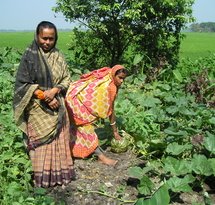
The situation in the southwest delta of Bangladesh is critical. Because of sea level rise, floods are increasing and the area is about to become uninhabitable, despite Dutch-style dikes and polders built in the previous century. Partner organisation Uttaran works with local communities on climate-friendly solutions that restore the living environment and give the inhabitants a say about their future and food production.
-
News / 29 June 2021
Fighting desertification in the Brazilian Sertão
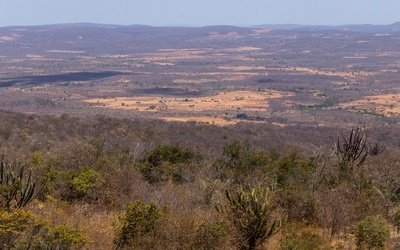
The farmers in the Sertão do Araripe region in Pernambuco state are smart. The small-scale family farmers know that securing a sustainable livelihood on the rich but vulnerable soils of the Sertão is only possible if they take good care of the environment. That means sound agriculture, making the best of every drop of available water, diligent use of natural fertilisers and pest-control and fighting for laws and policies that stimulate conservation rather than exploitation. The organisation CAATINGA helps the farmers to face the challenging conditions.
-
News / 20 June 2021
Organic wild rooibos in South Africa’s dryland
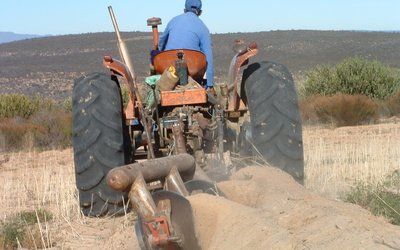
South Africa is the home of rooibos, an ancient, health giving herbal infusion, discovered thousands of years ago by the KhoiSan, indigenous peoples of the Southern part of Africa. During the last century, rooibos has been increasingly commercialised, mainly by white South African farmers who produce it on a very large scale, causing environmental damage, soil erosion and loss of biodiversity. Fortunately, small-scale, environmentally sound and community-led rooibos cultivation initiatives also exist. Our long-standing South African partner Environmental Monitoring Group (EMG) has, for more than two decades, been involved in this type of rooibos cultivation with the communities in the Suid Bokkeveld, in the western part of South Africa. Although it was not always easy, Noel Oettle, senior advisor at EMG, thinks this way of producing is the future.
-
News / 17 June 2021
Celebrating community led initiatives on World Desertification, Land Degradation and Drought Day
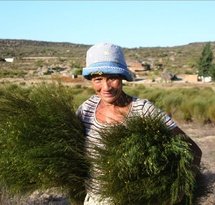
Today is World Desertification, Land Degradation and Drought Day. Such a day is more than needed to get attention for desertification, land degradation and drought that are threatening and hitting hundreds of millions of people in many regions throughout the world. While the causes - such as large-scale agriculture, use of pesticides, water extraction and climate change - are clear and need to be stopped, it is just as important to focus on solutions like restoration and sustainable land use.– in line with World Desertification, Land Degradation and Drought Day's theme for this year: 'Restoration. Land. Recovery. We build back better with healthy land', we will therefore especially focus on inspiring solutions during the next few weeks.




